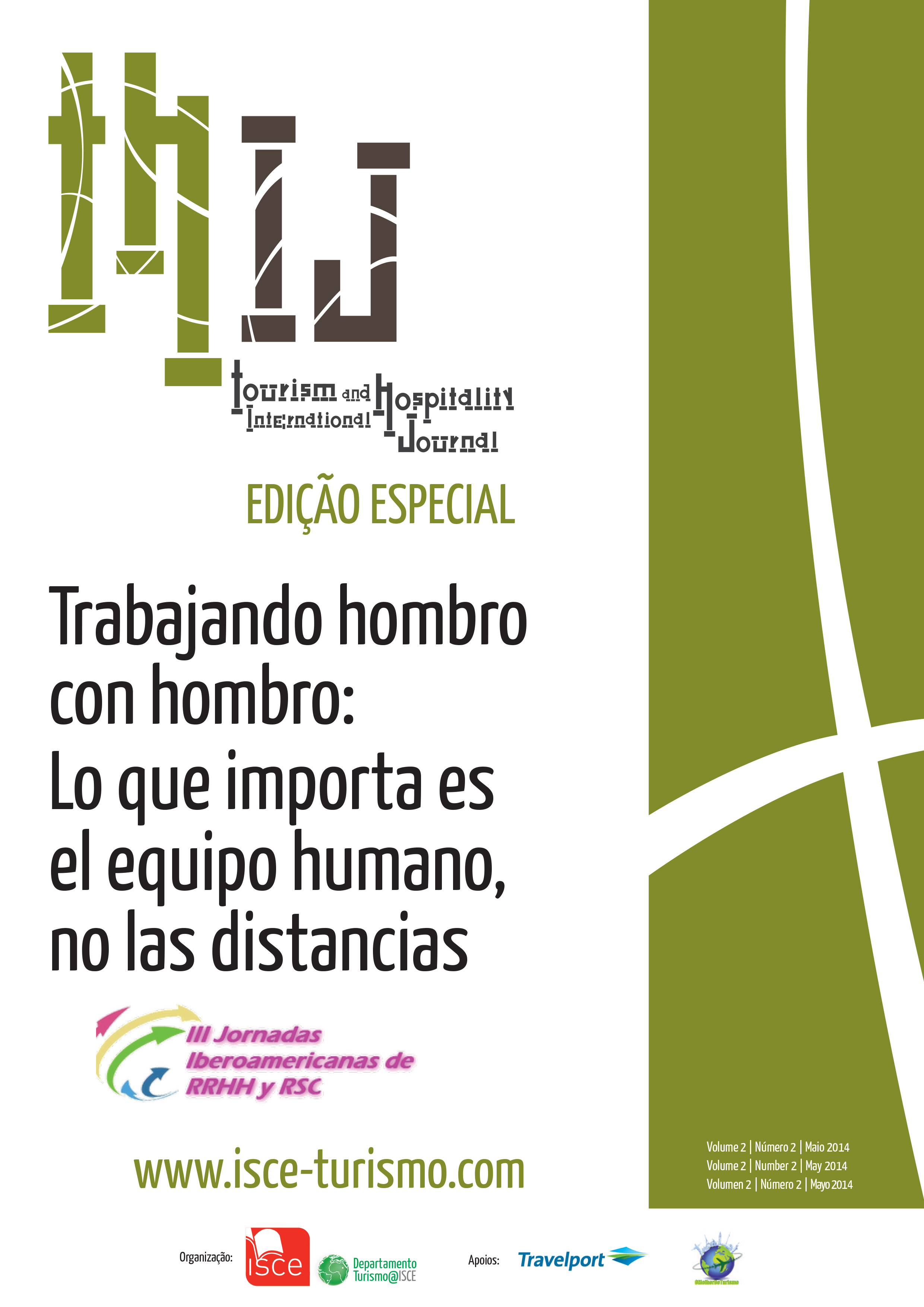El CRM: Una estructura exitosa para una herramienta estratégica en la gestión del sector hotelero
DOI:
https://doi.org/10.57883/thij2(2)2014.30143Palavras-chave:
CRM, Indústria hoteleira, Cloud computing, Estrutura estratégica, Estrutura bem-sucedidaResumo
A disponibilidade de sistemas de gestão de clientes na indústria hoteleira tem sido tradicionalmente vista como um enorme investimento e esforço que só as grandes cadeias são capazes de pagar. Hoje em dia, os novos avanços tecnológicos estão permitindo a reestruturação das operações usando um novo modelo de software, no qual os dados são armazenados na "nuvem" e a terceirização de serviços pode ser oferecida como uma alternativa. Este estudo fornece uma estrutura de tecnologia apropriada para aceder aos dados do cliente, analisa e recolhe as tendências mais recentes de marketing, opiniões de especialistas sobre empresas e organizações de turismo em Espanha e os mais recentes desenvolvimentos tecnológicos no mercado, para em conjunto capturar a estrutura de uma ferramenta de CRM bem-sucedida, que permite aos profissionais integrar todo o conhecimento adquirido a partir dos seus clientes, começando a oferecer "valor" tanto a nível individual como coletivamente. Nos resultados da pesquisa, descobrimos que o CRM pode ser uma ferramenta benéfica para a gestão da indústria hoteleira, embora o seu sucesso resida na sua estrutura.
Referências
Band, W. (2012). The Forrester Wave: CRM Suites for Mid Sized Organizatiers. Cambridge: MA: Forrester Research, Inc.
Bauer, C., Greve, G. & Gregor, H. (2011). Online targeting und controlling: Grundlagen-Anwendungsfelder–Praxisbeispiele. Wiesbaden (Alemania): Springer Gabler.
Becker, J. U., Greve, G. & Albers, S. (2009). The impact of technological and organisational implementation of CRM on customer acquisition, maintenance, and retention. International Journal of Research in Marketing, 26, 207-215.
Beijerse, R.P. (1999). Questions in KM: defining and conceptualising a phenomenon. Journal of Knowledge Management, 3(2), 94-109.
Boulding, W., Staelin, R., Ehret, M. & Johnston, W. J. (2005). Customer relationship management roadmap: What is known, potential pitfalls, and where to go. Journal of Marketing, 69, 155-166.
Chalmeta, R. (2006). Methodology for customer relationship management. The Journal of Systems and Software, 79, 1015-1024.
Chang, H. H. (2007). Critical factors and benefits in the implementation of customer relationship management. Total Quality Management, 18(5), 483-508.
Chen, I. J. & Popovich, K. (2003). Understanding customer relationship management-people, process and technology. Business Process Management Journal, 9(5), 672-688.
Chen, Q. & Chen, H.M. (2004). Exploring the success factors of eCRM strategies in practice. Journal of Database Marketing & Customer Strategy Management, 11, 333-343.
Claver, E., Pereira, J., De Juana, S. & Guerrero, A. (2004). Consecuencia de la presencia de nuevas tecnologías de la información y la comunicación en la rentabilidad, calidad, y recursos humanos de los hoteles de la Provincia de Alicante. V Congreso TURITEC, 53-70.
Clemons, E. K. & Row, M.C. (1991). Sustaining IT advantage: The role of structural differences. MIS Quarterly, 15(3), 275-292.
Clifton, R. (2009). Brands and branding (2ª edición). London: The Economist Books.
Dev, S. & Schultz, D. (2005a). Simply Siva. Marketing Management, 14(2), 36-42.
Dev, S. & Schultz, D. (2005b). A customer-focused approach can bring the current marketing mix into the 21st century. Marketing Management, 14(1), 16-22.
Foss, B., Stone, M. & Ekinci, Y. (2008). What makes for CRM system success - or failure? Database Marketing & Customer Strategy Management, 15(2), 68-78.
Garrido, A. & Padilla, A. (2012). CRM strategies in services companies: managerial recommendations for its implementation. Dirección y Organización, 46(Abril), 56-66.
Greenberg, P. (2010). The impact of CRM 2.0 on customer insight. Journal of Business & Industrial Marketing, 25(6), 410-419.
Hansotia, B. (2002). Gearing up for CRM: Antecedents to successful implementation. Journal of Database Management, 10(2), 121-132.
INE (2013). Encuesta Anual de Servicios 2012. Recuperado de http://www.ine.es.
Mendoza, L. E., Marius, A., Pérez, M. & Grimán, A. C. (2007). Critical success factors for a customer relationship management strategy. Information and Software Technology, 49, 913-945.
Piccoli, G., O’Connor, P., Capaccioli, C. & Alvarez, R. (2003). Customer relationship management: A driver for change in the structure of the US lodging industry. Cornell Hotel and Restaurant Administration Quarterly, 44(4), 61-73.
PriceWaterhouseCoopers (2006). Informe de coyuntura hotelera: situación y perspectivas del sector en España. Recuperado de http://k3.pwc.es/local/es/kc3/publicaciones.nfs.
Salojärvi, H., Sainio, L. M. & Tarkiainen, A. (2010). Organisational factors enhancing customer knowledge utilization in the management of key account relationships. Industrial Marketing Management, 39, 1395-1402.
Salvi, F. & Serra, A. (2014). New consumer behaviour: A review of research on eWOM and hotels. International Journal of Hospitality Management, 36, 41-51.
Sin, L. Y. M.; Tsé, A. C. B. & Yim F. H. K. (2005). CRM conceptualization and scale development. European Journal of Marketing, 39(11/12), 1264-1290.
Thompson, E., Goldman, M. & Mertz, S. A. (2010). Predicts 2011: CRM Enters a Three-Year Shake-Up. Stamford, CA: Gartner, Inc.
Verhoef, P. C., Reinartz, W. J. & Kraft, M. (2010). Customer engagement as a new perspective in customer management. Journal of Service Research, 13(3). 247-252.
Downloads
Publicado
Como Citar
Edição
Secção
Licença
Direitos de Autor (c) 2023 This work is licensed under a Creative Commons - Attribution 4.0 International (CC BY 4.0)

Este trabalho encontra-se publicado com a Licença Internacional Creative Commons Atribuição 4.0.
Este trabalho encontra-se publicado com a Licença Internacional Creative Commons Atribuição 4.0.






